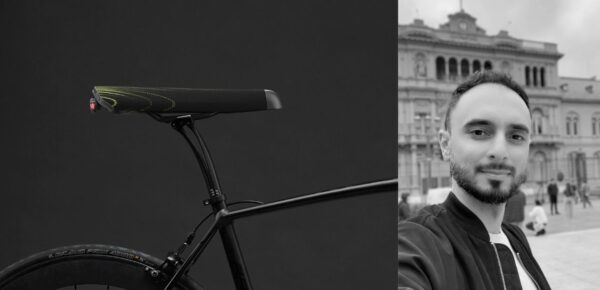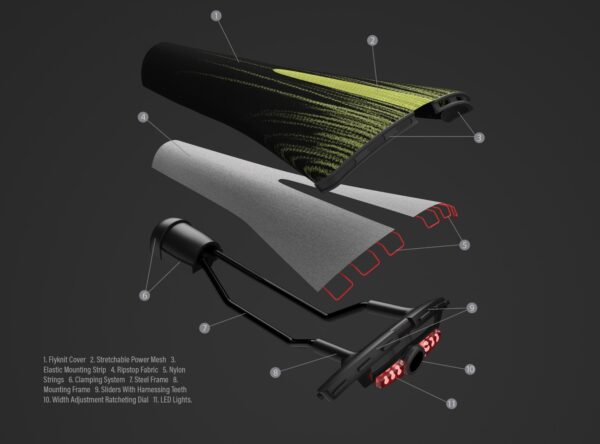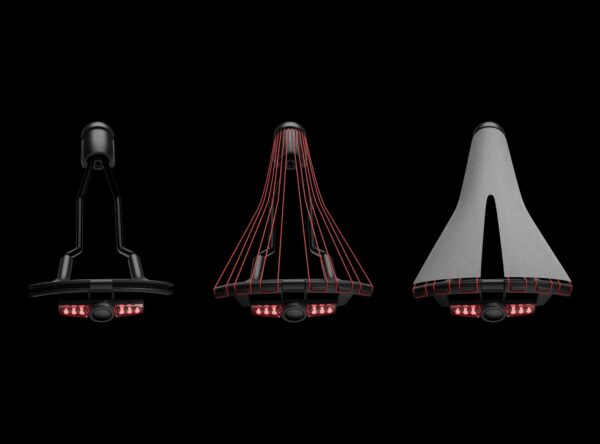A bike ride should feel like freedom, not a test of endurance for your sit bones. For many cyclists, especially women, the factory-installed saddle is often the first thing to go after just a few rides. Behzad Rashidizadeh, a recent graduate from Carleton University and winner of the FIT Design Awards Emerging Sport Gear Designer of the Year, set out to change that. His René Adjustable Width Bike Saddle is an innovative and sustainable prototype that adapts to each rider’s anatomy, improving comfort and reducing waste without the need for constant upgrades. Designed with adjustability, inclusivity and long-term use in mind, René could be the seat that finally fits everyone. In this interview, Behzad shares how engineering expertise, ergonomic research and empathy for the everyday rider came together to create a game-changing piece of cycling gear.

Can you tell us a bit about your background? What drew you to industrial design?
I come from an engineering background, which gave me a strong foundation in problem-solving, mechanics, and material science. But over time, I found myself drawn to the human side of design—the emotional connection people have with the products they use every day. Industrial design felt like the perfect bridge between technical precision and creative expression. It allows me to apply my engineering mindset to real-world challenges while also exploring aesthetics, ergonomics, and user experience. That blend of logic and empathy is what keeps me inspired.
What would you say is your personal design philosophy?
I believe that true beauty emerges from function. There’s an old saying in aviation: “If it looks good, it will fly good.” Fighter jets are engineered with zero compromise on performance—and yet their form is striking. To me, this proves that highly refined function is inherently elegant. That’s the kind of design I strive for.
My philosophy is deeply user-centered. That doesn’t just mean solving a need at the moment of use—it means thinking across the entire lifecycle of the product, from manufacturing to disposal. It’s about anticipating both current and future problems, and designing with empathy at every stage. When you truly understand your user, inclusivity and sustainability naturally become part of the equation. Every design decision I make balances the user’s immediate needs—like comfort, safety, and usability—with long-term goals such as environmental sustainability.
What is the inspiration behind the René saddle? Was there a specific moment, observation, or personal experience that sparked the idea?
The idea started from my own frustration as a casual urban rider struggling with the discomfort of the OEM saddle on my new bike. Curious if others felt the same, I began digging deeper—and found that many riders did, especially women, whose experiences were often overlooked. That realization led me to study bike ergonomics and sit bone anatomy, which ultimately shaped my goal: to design a saddle that’s not just comfortable, but inclusive of all riders.

What was the development process like for René?
I started by researching the evolution of bike seats and studying sit bone anatomy across different genders. That helped me narrow down my target users: casual and urban riders with upright or slightly forward riding postures, usually going for more budget-friendly bikes.
The Frame Design: I went through a few cardboard mockups to test out different mechanisms. Carbon fiber seemed promising at first, but its complexity and poor retrofitting capability made it less practical. So, I circled back to bent metal tubing and tested a slider mechanism to adjust seat width. This setup proved feasible and retrofit-friendly. I built and 3D printed a full-scale prototype around a metal frame to put it to the test.
The Strings: To experiment with how nylon strings could work for seating, I designed a jig and started playing with form and contour. I laminated the strings onto ripstop fabric using TPU sheets to check for durability—turned out better than expected.
Once I had all the parts together, I tested the tension mechanism for tightness and tolerances. The 3D printed version couldn’t hold my full weight, but the design showed solid structural potential.
What were some of the biggest challenges you encountered along the way?
One of the main challenges was keeping manufacturing costs low without sacrificing quality or functionality. I had to be mindful of the number of components and how they came together—fewer parts meant easier assembly, but also required more thoughtful engineering to make everything work seamlessly.
Another challenge was making sure the saddle was user-friendly post-purchase. I wanted riders to be able to easily replace the knitted cover or fine-tune the tension of the strings to their liking. Achieving that level of accessibility and modularity added complexity to the design process, but it was essential to support long-term use and customization.
Of course, all of this had to come together in a product that could handle the stresses of real-world riding—so finding the right balance between adaptability, durability, and simplicity took time and a lot of testing
Was gender inclusivity a key consideration from the beginning? How did it influence your design choices?
Yes, gender inclusivity was a major factor from the very start. I noticed that manufacturers often equip bicycles with small, low-cost saddles to reduce overall production expenses—anticipating that many riders will replace them anyway. Unfortunately, this approach disproportionately affects female riders, who naturally tend to have wider pelvic structures and often experience discomfort or even pain with these generic seats.
That realization shaped the core philosophy behind René. By designing a saddle that adjusts to individual sit bone widths, I wanted to eliminate the need for riders to discard the stock saddle just to find something more suitable. It wasn’t just about ergonomics—it was about making a product that could adapt to a broader spectrum of users from the start.
Inclusivity and sustainability go hand-in-hand here. By creating a solution that fits more people—particularly those historically overlooked—we also reduce waste and extend the functional life of the bike’s original components. René became a chance to address both problems with one product, and to show how empathy in design can lead to real impact.
How did sustainability factor into your decision-making process as a young designer?
Sustainability wasn’t just a consideration—it was the driving force behind René’s design. My goal was clear: improve rider comfort while reducing unnecessary waste, especially the premature disposal of OEM saddles that often never reach the end of their intended life cycle. I chose a metal frame that could retrofit onto existing saddle mounts, making it easier for manufacturers to adopt this design without overhauling their production line.
I understand that eliminating every unsustainable component in a product can be costly—for both manufacturers and consumers. So instead of chasing perfection, I focused on durability and longevity as key ways to lessen environmental impact. If a product lasts longer and adapts to the user’s changing needs, it naturally reduces waste. That mindset guided every design decision I made for René.

Congratulations on being named Emerging Sport Gear Designer of the Year! What does this recognition mean to you at this stage in your career?
I’m truly honored to receive this recognition—especially as it’s my first in the category of sports equipment. It’s opened up a whole new avenue I hadn’t previously considered myself working in, and that’s incredibly exciting. I’m also proud that the Fit Design Award celebrates values like inclusivity and sustainability. Seeing those principles rewarded sends a powerful message to emerging designers: thoughtful, responsible design matters. It inspires me—and hopefully others—to keep pushing towards a more conscious and accessible future in design.
Looking ahead, what do you envision for your future? Are there other areas in sports or mobility where you see similar opportunities for change?
I’m especially drawn to designing wearables for sports and rehabilitation. It’s the sweet spot where functionality, human performance, and innovative tech come together. I find the overlap between robotics and wearable design fascinating—it opens up exciting possibilities for enhancing movement, recovery, and even long-term health outcomes. There’s something incredibly rewarding about creating products that not only push athletic performance but also support people through rehabilitation and healing.
Working in this space allows me to explore biomechanical principles and empathetic design—thinking about how materials, sensors, and form factor can all work together to serve the human body better. It’s a field where both precision and compassion matter, and I love that balance.










